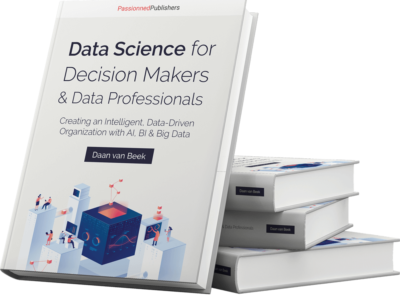Avoid unbridled investment in unproven technology
70% of all BI projects fail. There should be a great deal of concern about this. Organizations keep building data warehouses and data lakes. Despite the huge data mountains, 75% of executives don’t trust their own data (source: HFS Research). They ignore the data and make decisions irrationally. To close the gap between people and technology, the data literacy gap, Thomas Abramse and Caroline Raaijmaakers, data coaches at Passionned Group, are taking to the barricades. Out of every euro you want to invest in a BI project, you should immediately skim half a euro and reserve it for training and education. That’s the only way to develop employee data literacy. Investing in data literacy does require a different mindset. Our data coaches explain how.
Prevent unbridled investments
How do you avoid unbridled investment in data warehouses, data lakes and dashboards? And how do you make your organization and people more future-proof?
In this blog, we first explore the causes of disappointing BI results. Disappointing in the sense that the promised returns do not materialize. Or worse: mounting losses due to wrong decisions, taken by managers or employees who turned out not to be data literate enough. We examine the interaction between technology & people and the zeitgeist, highlighting two different roles: the decision maker (usually the line manager) and the data analyst. Finally, we tell you how best to train data skills.
Managers have different needs and priorities than employees
An earlier study by Binnenlands Bestuur on digital literacy among Dutch civil servants found that the gap between technology and people can be wide. For example, managers were found to be most in need of new technology, capacity, and budget, while employees were most in need of education, training, and practical tools (e.g., software) to apply new technology in their daily work.
So the priorities are not quite in sync. And this is then reflected in investment behavior. Managers overestimate the added value of technology. It explains why, relatively, the most money is invested in technology. Investments in people lag far behind. Technology is apparently more tangible and rational, people are fickle and emotional.
The sentiment around data
Quirkiness or emotions can indeed play a role in the sentiment surrounding investments and data, according to Thomas. “If your team manager happens to be an enthusiastic, data-driven manager, they will soon have the entire team in tow. Data drive then spreads like an oil slick. Conversely, skeptical and not data-minded managers will always make up excuses to avoid going data-driven. Then you often hear “we still need to change the source system first,” “let’s complete that acquisition now,” and “we still need to get data quality right first.” In short: excuses not to do something because of uncertainty are always there. Caroline also observes that organizations struggle with uncertainty: ‘I do recognize this, but I wonder if there isn’t also ignorance.’
Training costs are forgotten
Many organizations do not realize the importance of data literacy training. Caroline says: “The item Training and education is often not included in the budget, or as a PM item (“we’ll look at that later”). As a result, those costs are forgotten. And when it comes to data-drivenness, like Thomas, I believe in the principle of the oil spill. Passionate data-driven teams can ignite and inspire other teams. When you see or experience all you can do with data, the willingness to change improves automatically. Training does require intrinsic motivation. Managers who send their employees on mandatory courses are counterproductive. The average level of data literacy in organizations is worryingly low.
Data literacy training program for decision-makers and data analysts
 Data skills can be trained. We are committed to closing the data gap in organizations. That is why we have now developed an in-company training course under the banner of Passionned Academy focused on data skills. During this training, both decision-makers and data analysts are given the tools they need to score even in these uncertain times in separate and joint sessions. They gain inspiration, solve cases, create their own ideal profile of the data-driven decision maker, go through the data-driven PDCA, share experiences in a community, and so on.
Data skills can be trained. We are committed to closing the data gap in organizations. That is why we have now developed an in-company training course under the banner of Passionned Academy focused on data skills. During this training, both decision-makers and data analysts are given the tools they need to score even in these uncertain times in separate and joint sessions. They gain inspiration, solve cases, create their own ideal profile of the data-driven decision maker, go through the data-driven PDCA, share experiences in a community, and so on.
Copycat behavior leads to grave mistakes
According to Caroline, irrational investment behavior is also worrisome. ‘Executives show copycat behavior when they ask, “why don’t we have a predictive model yet?” Or when they exclaim, “make me one of those dashboards too” or “how many paid licenses for ChatGPT do we need so we don’t miss the boat?” Often they have heard something on the golf course or in the corridors of a U.S. conference. The result is a mismatch between the technology purchased and the actual needs of the organization. As a data coach, we can also perform a reality check for the client. In any case, copycat behavior can lead to capital blunders. Organizations are then suddenly stuck with a Porsche, while a Volkswagen Golf would probably have sufficed just as well. Or there is a Ferrari, while no one has been trained as a racing driver.’
According to Thomas, the cause for this disappointing state of affairs is crystal clear. ‘Organizations make little or no investment in data literacy. As a result, their employees cannot handle the available technology, and drop out. The investment in technology is then a waste of money.’ 70% of investments in BI technology disappear down the drain (source: Gartner).
The success of BI
 Thomas: “As data coaches with a BI background, we have a very different, opinionated view of the world and people. That’s why we have a very strict definition for measuring the success of Business Intelligence. Only when BI has demonstrably contributed to better margins, shorter lead times, happier customers, and more satisfied employees, can it be called a success. BI must therefore ensure better decisions at all levels and result areas.’
Thomas: “As data coaches with a BI background, we have a very different, opinionated view of the world and people. That’s why we have a very strict definition for measuring the success of Business Intelligence. Only when BI has demonstrably contributed to better margins, shorter lead times, happier customers, and more satisfied employees, can it be called a success. BI must therefore ensure better decisions at all levels and result areas.’
With this strict definition in mind, most organizations still have a long way to go. Success with BI, according to the data coaches, doesn’t fall into your lap. If the results are disappointing, you have to look for the causes, otherwise you have a big problem. In practice, they find that after implementation, the data warehouse, the data lake, or the dashboards are soon regarded as pieces of furniture. Nobody cares anymore, let alone does anything serious with them. And that is a missed opportunity.
Thomas: “We dare to ask critical questions: what is actually the added value of your data warehouses, data lakes and KPI dashboards? Are your people properly trained? For what problem is the technology a solution? And so on. In short: we put things into perspective and are also able to make people enthusiastic again.
You can only spend each euro once
Of course, Caroline and Thomas also know that you can only spend each euro once. That’s a given. After all, managers often choose to invest that euro in technology and not in people, because technology is tangible. Companies are now used to reserving large sums of money for new technology. Think of that very expensive data warehouse, the overvalued Data Vault, or the popular data lake. If the return on investment subsequently fails to materialize, those directly involved have no idea why. They do wonder: why do our employees fall back into their old inefficient ways of working, despite the potential of data-driven work?
 Figure 2: Out of every euro you want to invest in a BI project, immediately reserve half a euro for training and education
Figure 2: Out of every euro you want to invest in a BI project, immediately reserve half a euro for training and education
Training: from procrastination comes discontinuation
Thomas elaborates on the possible causes: “Organizations still work from silos, that’s a fact. If IT recommends the purchase of certain software or hardware at the insistence of the business, the HR department usually decides on the budgets for the associated training and education. There is noise in between. And of course, budgets are tight in every company: even training money can only be spent once. Because you can always postpone training, this makes it a relatively easy savings target. And procrastination often leads to cancellation. Then you are left with a BI platform that nobody uses because there are no well-trained users who can work with it. That’s a situation I call the data literacy gap.”
Training is indeed a closing entry
Caroline also recognizes this situation: “Training is indeed often a closing item. In my opinion, the core of the problem is not the tight budgets. The training objectives are often formulated too vaguely. In addition, the actual training goals and needs to be achieved by the organization are missing. Some answers should be clear, such as what you want to achieve, what decisions and change processes you want to support and who is the training intended for? We can support organizations so that you train the right people. Furthermore, I notice with clients I advise that people are sometimes afraid of data. If you patiently explain how to read data, how to interpret a dashboard, or how to use Power BI effectively, people sometimes immediately start to stress. “Do I have to be able to do all this myself?” they then sigh. The lack of willingness to change, the well-known resistance to change, also plays a role in this blockade. Fear dominates.”
The spirit of the times: people ignore evidence-based practice
Thomas also identifies another roadblock that may be symptomatic of our zeitgeist: denial. ‘People deny or distort the data or are simply not interested in the facts and create their own version of the truth.’ This is evidenced in part by an Oxford Review article on evidence-based practice. The author’s conclusion: “People don’t want evidence-based practice. People prefer narratives, constructed versions of the truth to stories based on facts or data. For this, see also our blog on how to deal with disinformation. “People also find it too much hassle to quantitatively substantiate an investment request and formalize it in a business case. They’d rather trust the stories and experiences of colleagues,” is Caroline’s experience.
Measuring data literacy at the individual level
 Both data coaches are used to thinking in practical solutions and have already helped several organizations by addressing poor data literacy at the root.
Both data coaches are used to thinking in practical solutions and have already helped several organizations by addressing poor data literacy at the root.
Caroline: “We at Passionned Group have developed an easy tool with which we can perform a baseline measurement of the level of data literacy. At the individual level, but also at the team or organizational level if desired.
In particular, we examine the attitudes and skills of individuals and the extent to which they are able to think critically. Is the person able to assess how reliable the data is? Is the employee aware of their own biases? And so on.”
Data is always leading
Indeed, heeding insights and new knowledge gained from data is never optional, according to Thomas. “If the data says you have to turn left and the decision-maker says we’re going right anyway, there are consequences”. He gives a current example. “In the recent earthquake in Turkey, there was one “headstrong” mayor of a small village who had strictly adhered to building codes. His integrity, fearless attitude and holy faith in the data was rewarded. In the village of Erzin, no buildings collapsed in the great earthquake. This may partly be due to coincidence, but at least the mayor can show that he issued the right permits based on the available data”.
Both Thomas and Caroline firmly believe that data should always be leading in decision-making. Data literacy brings the world of data and humans closer together and therefore it gives you more certainty for higher quality decision making.
Data literacy brings the world of data and humans closer together and therefore it gives you more certainty for better quality decision-making
But for substantiation, you really have to go to the data analysts. They will have to dive much deeper into the data mountain. That goes far beyond whether someone can read a graph. Data analysts sometimes have to run a complete marathon.
The Data Science book for Decision Makers & Data Professionals  This best-seller covers every essential organizational and technical facet of Data Science, AI, and machine learning. Learn how to build an intelligent, data-driven organization using the many examples and applications of data science and algorithms in this book. After reading the 10 chapters of this data science book, you will be very well prepared to start a data science project in your organization or your clients’ organization.
This best-seller covers every essential organizational and technical facet of Data Science, AI, and machine learning. Learn how to build an intelligent, data-driven organization using the many examples and applications of data science and algorithms in this book. After reading the 10 chapters of this data science book, you will be very well prepared to start a data science project in your organization or your clients’ organization.
Get and stay in the flow: 5 tips
From now on every euro you invest in technology, you invest proportionally in people as well. But how to make sure the process doesn’t get bogged down?
- Make sure you embed BI in a PDCA cycle. You can read more about it on the PDCA page.
- Establish a community. Have decision-makers from different domains and data analysts learn from each other in a community. That way, they can pass the baton to other colleagues and that’s how you keep the “Olympic fire” burning.
- Everything starts with data quality: raise awareness and point out the importance of data quality to everyone in the organization. Focus not only on the decision makers and data analysts but on everyone who works with data.
- Have a baseline data literacy assessment. If a baseline measurement allows you to see at a glance what the current level of data literacy is, you “automatically” stumble upon gaps in training needs. That way, you can never forget to budget the necessary training dollars.
- Link BI & Analytics to concrete decisions. The ultimate goal of BI and decision models is always: do they lead to better, faster, and more informed decisions?
In conclusion
Organizations that are able to effectively close the data literacy gap have a competitive advantage. Because they also invest proportionately in people in a tight labor market, they retain their talents. And that investment pays off handsomely. Both data coaches would like to convince you of that as well. Contact us here.

 Figure 1: The data literacy gap visualized
Figure 1: The data literacy gap visualized
 Caroline Raaijmaakers, business administrator with a specialization in Marketing, is an expert in data-driven organizational development and project, program, and portfolio manager. She is a professional, decisive connector who has proven to be able to combine data, people, systems, new technologies, and processes and make them work together in a practical way applicable to people and organizations. As a data coach, she has extensive experience with BI Road Maps, Customer Life Time Value, Analytics, Customer Intelligence,
Caroline Raaijmaakers, business administrator with a specialization in Marketing, is an expert in data-driven organizational development and project, program, and portfolio manager. She is a professional, decisive connector who has proven to be able to combine data, people, systems, new technologies, and processes and make them work together in a practical way applicable to people and organizations. As a data coach, she has extensive experience with BI Road Maps, Customer Life Time Value, Analytics, Customer Intelligence, 

